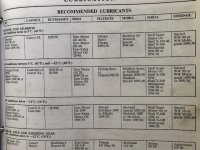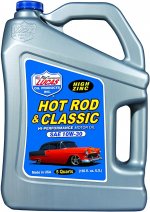-
 Hi Guest!
Hi Guest!
If you appreciate British Car Forum and our 25 years of supporting British car enthusiasts with technical and anicdotal information, collected from our thousands of great members, please support us with a low-cost subscription. You can become a supporting member for less than the dues of most car clubs.
There are some perks with a member upgrade!**Upgrade Now**
(PS: Subscribers don't see this gawd-aweful banner

Tips
- We have a special forum called "Member Articles" where you can submit actual articles for consideration for publication. Learn More
- Don't have an Avatar? If not, your avatar will default to the 1st character in your username. Go into "Account Details" to change your Avatar.
- Some basic forum navigation info: click
Hey - did you know if you click on the title of a thread it will take you to the first unread post since you last visited that thread?
- Hey Guest - Is your British Car Club in our Clubs database? If not, send me a PM - Basil

- Looking for a local club? Click the "Clubs" tab above and browse hundreds of clubs world-wide.
- Add Android or iPhone APP: click
- Did you know - any picture or video you add in your posts in any marque-specific forum will also get added to the Media Gallery automatically.
- A few more tips about posting and replying: click
- Hey there Guest - be sure to keep your profile page up to date with interesting info about yourself: learn more
- More tips and tricks on Posting and Replying: click
 STOP!! Never post your email address in open forums. Bots can "harvest" your email! If you must share your email use a Private Message or use the
STOP!! Never post your email address in open forums. Bots can "harvest" your email! If you must share your email use a Private Message or use the  smilie in place of the real @
smilie in place of the real @
- Want to mention another member in a post & get their attention? WATCH THIS

- So, you created a "Group" here at BCF and would like to invite other members to join? Watch this!
- Hey Guest - A post a day keeps Basil from visiting you in the small hours and putting a bat up your nightdress!
- Hey Guest - do you know of an upcoming British car event?
 Pretty Please - add it to our Events forum(s) and add to the calendar! >> Here's How <<
Pretty Please - add it to our Events forum(s) and add to the calendar! >> Here's How << 
- Hey Guest - you be stylin'
Change the look and feel of the forum to fit your taste. Check it out
- If you run across an inappropriate post, for example a post that breaks our rules or looks like it might be spam, you can report the post to the moderators: Learn More
- If you would like to try some different "looks" or styles for the site, scroll to the very bottom, on the left and click the Style Selector.
You are using an out of date browser. It may not display this or other websites correctly.
You should upgrade or use an alternative browser.
You should upgrade or use an alternative browser.
Offline
Per the driver's handbooks I looked at, either a straight 30 or a 20W30 oil was recommended for all models. It's interesting to see that some oils didn't have a grade - just Castrol X.L. or Mobiloil A.
I've always used 20W50 - Castrol and, more recently, Valvoline VR-1 in our '62 tri-carb and '80 MGB.
I've always used 20W50 - Castrol and, more recently, Valvoline VR-1 in our '62 tri-carb and '80 MGB.
kodpkd
Jedi Hopeful
Offline
Why do you use 50 weight oil instead of the recommended oil?Per the driver's handbooks I looked at, either a straight 30 or a 20W30 oil was recommended for all models. It's interesting to see that some oils didn't have a grade - just Castrol X.L. or Mobiloil A.
I've always used 20W50 - Castrol and, more recently, Valvoline VR-1 in our '62 tri-carb and '80 MGB.
Last edited:
twas_brillig
Jedi Knight
Offline
Well, for one reason, oils have changed since 1960 - i think that the broadest multi-grade you could get back then was 10-30. These days, I use 10W40, 1200 ppm zinc minimum. I've pretty much standardized on a diesel oil (Shell Rotella 10W40; the VR-1 is better, but I'm a cheap bugger)) as it has adequate zinc, is cheap, and I change more based on years than miles. And the original manuals sure recommended a lot more frequent oil changes than modern engines.
I dunno if I could even find 20-30 wt.
I assume that you're driving mostly at above freezing temperatures (those oxygen molecules must get really lonely, up at Colorado altitudes) so a minimum 20 weight should be fine at the lower end; you've got pretty moderate temperatures so the old 10W30 should be fine too, but I'll stick with the 20W40. . Heck, I've got an old Harley engined Buell motorcycle with 20-50 in it, and fired it up just before Christmas at somewhat below freezing temperatures to finish topping off the fuel tank and wanted to make sure that the fuel preservative was properly mixed. There's no practical advantage for running straight grade oil (my opinion) for the summer driving our vehicles experience; we use straight 30 weight only in our lawnmower. And you could probably start a holy war just on the subject of the 'best' oil. Good fortune on this! Doug
I dunno if I could even find 20-30 wt.
I assume that you're driving mostly at above freezing temperatures (those oxygen molecules must get really lonely, up at Colorado altitudes) so a minimum 20 weight should be fine at the lower end; you've got pretty moderate temperatures so the old 10W30 should be fine too, but I'll stick with the 20W40. . Heck, I've got an old Harley engined Buell motorcycle with 20-50 in it, and fired it up just before Christmas at somewhat below freezing temperatures to finish topping off the fuel tank and wanted to make sure that the fuel preservative was properly mixed. There's no practical advantage for running straight grade oil (my opinion) for the summer driving our vehicles experience; we use straight 30 weight only in our lawnmower. And you could probably start a holy war just on the subject of the 'best' oil. Good fortune on this! Doug
kodpkd
Jedi Hopeful
Offline
I think the 10W-40 isn't that far off of the 20W-30 but going to a 50 weight oil when the manual calls for 30 weight is a stretch. I am still trying to find the manual that calls for 50 weight, mine says 30 weight. 1961 BT7.
I also wonder if guys are thinking the 20 in 20W-50 is a weight. It isn't! 20W-50 oil is never 20 weight. It does help in cold starting but as soon as the engine is warm it is full 50 weight oil. The 20W stands for "20 degrees winter", 20* winter. The oil doesn't get thinner when it is cold.
I also wonder if guys are thinking the 20 in 20W-50 is a weight. It isn't! 20W-50 oil is never 20 weight. It does help in cold starting but as soon as the engine is warm it is full 50 weight oil. The 20W stands for "20 degrees winter", 20* winter. The oil doesn't get thinner when it is cold.
Bob_Spidell
Yoda
Offline
I think many (most?) of us use a 20W-50 oil because its somewhat greater viscosity might give a PSI or two greater oil pressure and because 20W-50 is the only grade that is likely to contain adequate ZDDP, known for its anti-wear and protective properties (particularly for cam lobes and lifter surfaces). Most new cars--I believe some BMWs are one exception--use lower vis oils since their engines are built with smaller machining tolerances and the thinner oils give a little bump in MPGs. The lower vis oils have less ZDDP since all new cars have catalytic converters--if they haven't been stolen--and ZDDP damages them. I don't know the whole story, but years ago my local parts house yanked all their Valvoline VR-1 20W-50 off the shelves and couldn't say why; that was about time California--it's always California, isn't it?--was changing its requirements for oils due to the catalytic converter issue. It was back on the shelves a year or two later so some sort of compromise must have been worked-out.
You really can't go wrong with multi-viscosity oils, even if you don't live in a cold climate. A multi-vis oil makes for somewhat easier cranking and gets to the top end quicker. Some argue that since multi-vis oils start with a thinner base oil and add viscosity improvers ('VIs') to give the greater hot rating they will shear quicker and lose lubricating effectiveness, which is probably the case but I'm not a believer in extended oil changes anyway. My quad ATV, Gator, zero-turn mower, rototiller, edger, gopher gasser, compacter, Ranger and Lincoln get Costco's finest 5W-30 synthetic* (at less than $5/qt). The 2 ancient tractors get the cheapest 10W-40 I can find and my Mustang gets Ford's recommended 5W-20 semi-syn with my dealer's 'free oil changes for life' (although Ford does recommend a higher vis oil for racing, to be changed before and immediately after races). Some too-clever-by-half types decided 5W-20 was too thin and dumped 10W-30 and thicker oils in their Modular engines and broke their timing chain tensioners.
*
I look for sales and stock up.
You really can't go wrong with multi-viscosity oils, even if you don't live in a cold climate. A multi-vis oil makes for somewhat easier cranking and gets to the top end quicker. Some argue that since multi-vis oils start with a thinner base oil and add viscosity improvers ('VIs') to give the greater hot rating they will shear quicker and lose lubricating effectiveness, which is probably the case but I'm not a believer in extended oil changes anyway. My quad ATV, Gator, zero-turn mower, rototiller, edger, gopher gasser, compacter, Ranger and Lincoln get Costco's finest 5W-30 synthetic* (at less than $5/qt). The 2 ancient tractors get the cheapest 10W-40 I can find and my Mustang gets Ford's recommended 5W-20 semi-syn with my dealer's 'free oil changes for life' (although Ford does recommend a higher vis oil for racing, to be changed before and immediately after races). Some too-clever-by-half types decided 5W-20 was too thin and dumped 10W-30 and thicker oils in their Modular engines and broke their timing chain tensioners.
*
I look for sales and stock up.
Attachments
Bob_Spidell
Yoda
Offline
I think the 10W-40 isn't that far off of the 20W-30 but going to a 50 weight oil when the manual calls for 30 weight is a stretch. I am still trying to find the manual that calls for 50 weight, mine says 30 weight. 1961 BT7.
I also wonder if guys are thinking the 20 in 20W-50 is a weight. It isn't! 20W-50 oil is never 20 weight. It does help in cold starting but as soon as the engine is warm it is full 50 weight oil. The 20W stands for "20 degrees winter", 20* winter. The oil doesn't get thinner when it is cold.
This manual covers all Healey 6-cyls (including BT7s):
From: > Austin-Healey 100-Six and 3000 Repair Information 1956-1968 - Bentley Publishers - Repair Manuals and Automotive Books <
From the Bentley manual:
Attachments
Offline
I use Valvoline VR-1 20W-50. As shown by Bob, the Bentley manual lists 20W-50 for the 6-cylinder engine and transmission at temperatures at or above 41F. VR-1 has the correct amount of ZDTP and a low viscosity index.
Offline
It's not 50 weight oil. A single viscosity grade oil, like a SAE 50 grade oil, has a viscosity index of 100.What is a low viscosity index? It's 50 weight oil. 50 weight oil has a different viscosity at every temperature, but for standards is recorded at 100*C.
We're talking about a multi-grade viscosity oil, 20W-50. At low temperature, 0F, it has a viscosity like a SAE 20 grade oil, and at high temperature, 100F, it has the viscosity of a SAE 50 grade oil. True, all oils are more viscous at low temperatures, and the viscosity index measures the amount of variation from the viscosity curve of a single viscosity grade oil. To achieve this, viscosity modifiers are used. This usually means that the refiner starts with a SAE 20 oil, adds viscosity modifiers until the oil has a high-temperature viscosity of a SAE 50 oil. These viscosity modifiers can break down under shear, reducing the viscosity at higher temperatures. A viscosity index should be below 150-160 to maintain shear stability. I recall that VR-1 has a viscosity index of ~124, well below 150.
kodpkd
Jedi Hopeful
Offline
Look at this chart carefully. Look at the 0W-30 chart and compare it to the straight 30 weight oil. Look at the Dyn viscosity from 100*c to 0*c. In both cases the oil gets thicker as the temp gets colder, the 0W-30 just doesn't get as thick, but it does get thicker.
The point is,,,,,, don't think you are getting 20 weight oil in your car by using 20W-50.

 wiki.anton-paar.com
wiki.anton-paar.com
The point is,,,,,, don't think you are getting 20 weight oil in your car by using 20W-50.

Viscosity of Engine Oil – viscosity table and viscosity chart | Anton Paar Wiki
Find viscosity tables and charts for engine oil at multiple temperatures (viscosity and density values with their source).
twas_brillig
Jedi Knight
Offline
thanks for the graphs. Heck of a difference at 0C between 10-40 and 10-60. Sure helps visualize why I had to squeeze the oil out of a bottle of 10-30 back in my youth on a cold morning at the gas station when I'd checked the oil and it was down a litre, and I pulled the 10-30 out of the trunk, and it would absolutely not pour .
Offline
Read what I said more carefully.So the colder the oil gets the thinner it is? Sorry, just not true. Like I said,,,, the 20 is a temperature rating, not a weight. The oil is rated to be a certain viscosity down to 20*,,,,, certainly thicker in viscosity than a 50 weight oil at 100*C.
DerekJ
Luke Skywalker
Offline
With multi grade oils such as 20W-50 the W stands for Winter not ‘weight’. So it’s a 50 grade oil but in winter, ie low temperatures, it flows like a 20 weight oil but is still 50 weight. Multi grade oils did not exist when Healeys first appeared and that’s why 30 weight was recommended. 50 would have been too thick at winter temperatures.
prb51
Luke Skywalker
Offline
20w oil will flow at low temps...that is what it is designed for...a good choice is 15w/50 too for older cars.So 0W-30 flows like 0 weight oil? What is 0 weight oil?
0 weight oil is what the Germans wanted on the Russian front.... it will flow at all weather/temp points and should only be used in cars designed for it with high modern tolerances like my Porsche 718.
I use 20w50 in my new to me AH.... there was only a slight uptick in oil psi and still where it should be indicating there are no issues using that weight and many protective reasons to do so. The tolerances in an AH engine ain't an issue.
Last edited:




